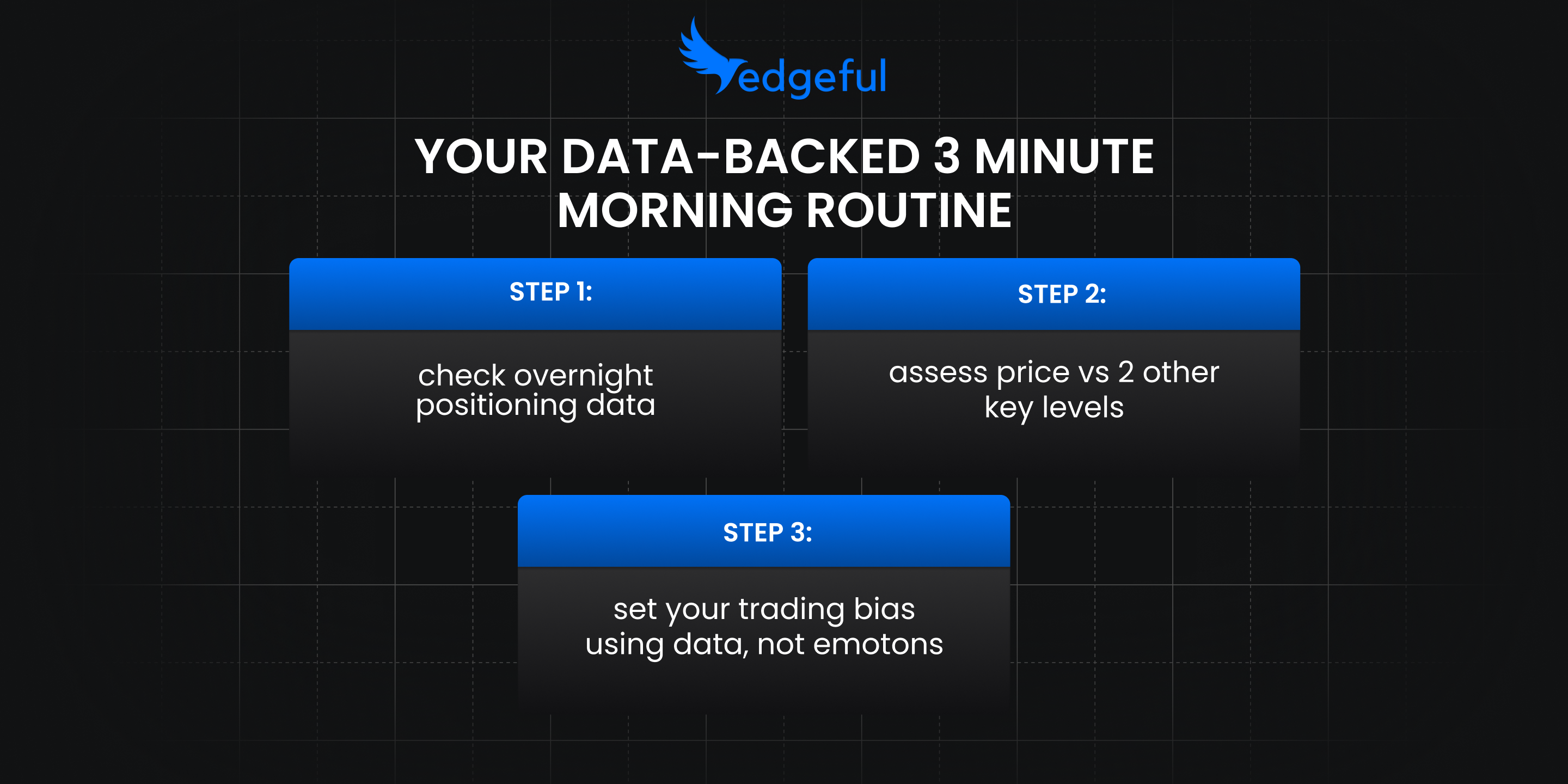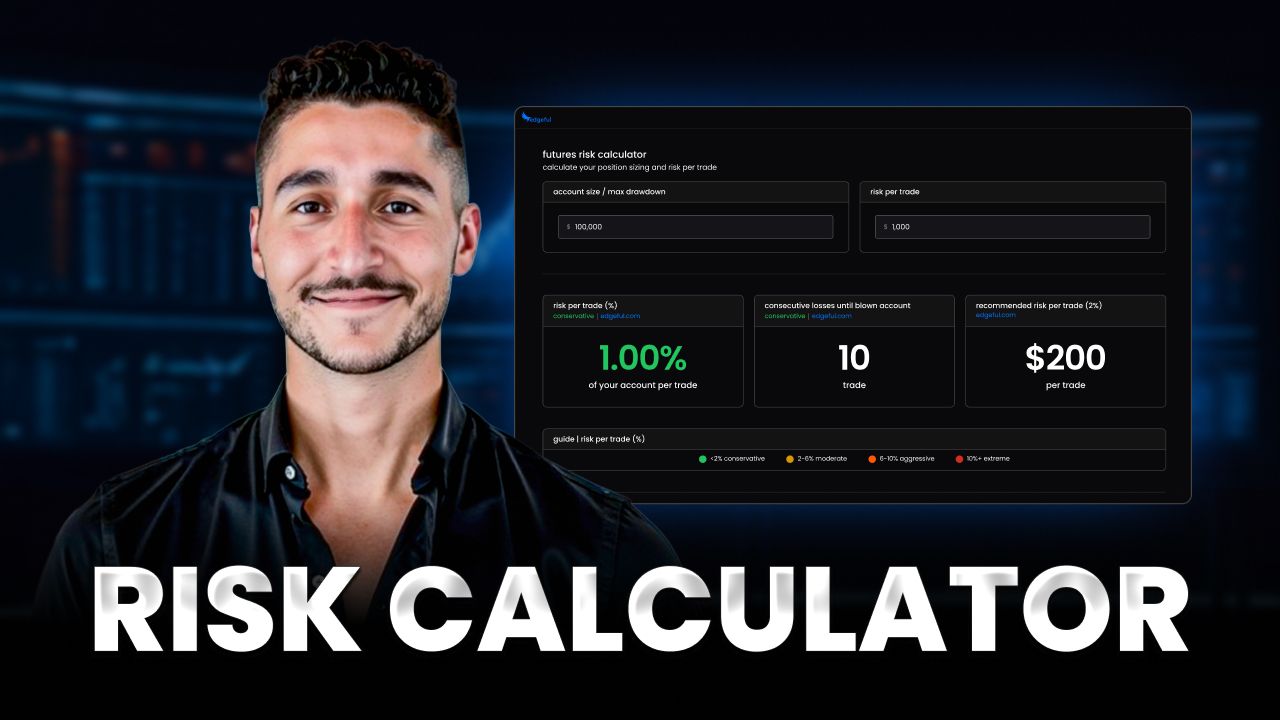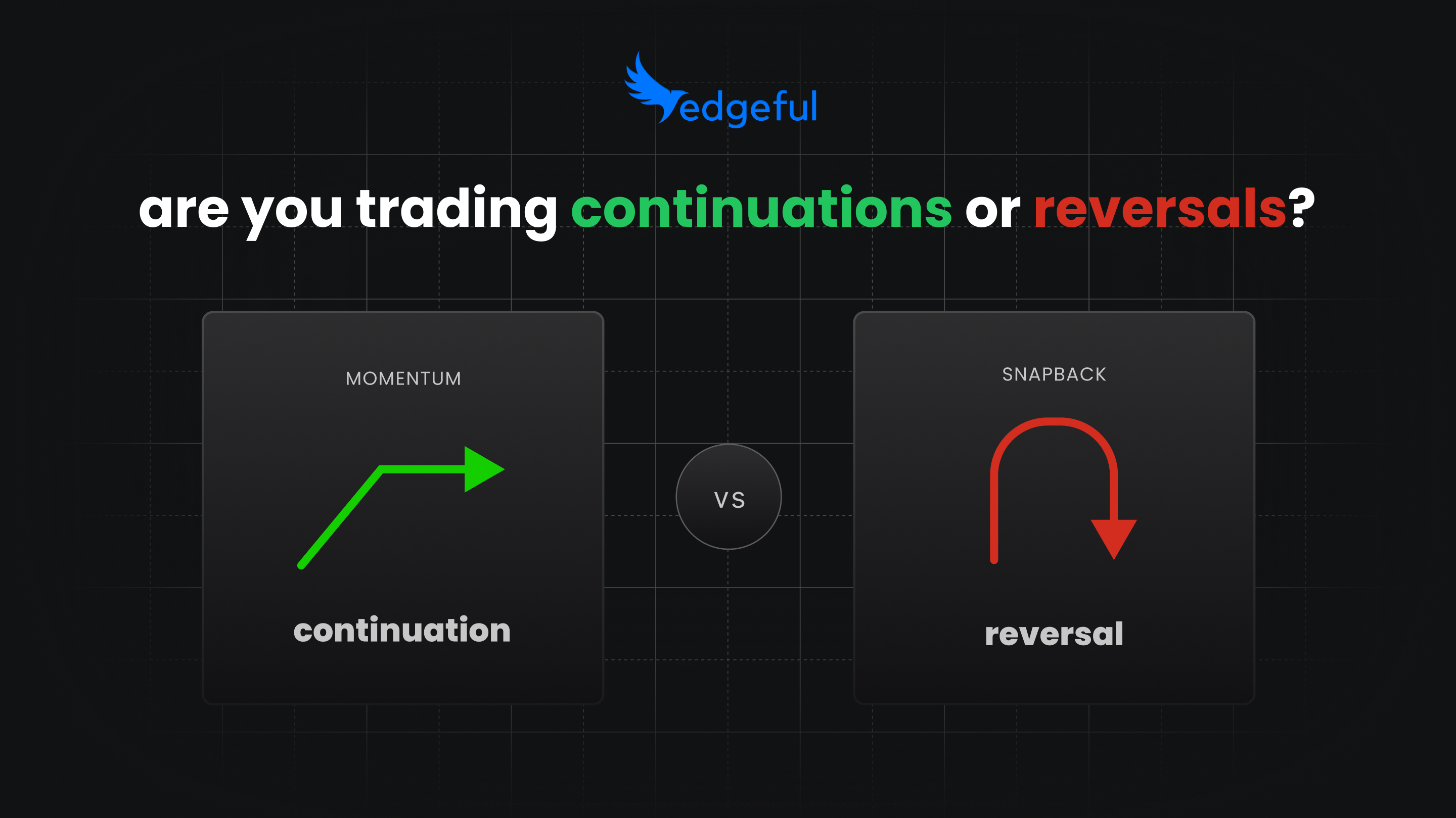day trading routine: the 3-minute morning system that removes guesswork

most traders wake up, grab their coffee, open their charts, and immediately start looking for trades without any real way to build their bias for the day. no plan. nothing they repeat every morning. just hoping something "looks good" and that their trades work out.
then they wonder why they're getting chopped or blowing accounts week after week.
I used to be the same way... until I realized that the most successful traders I know all have one thing in common: they never start trading without a clear bias based on data, not emotions.
table of contents
- the problem with most day trading routines
- why successful traders follow systematic morning routines
- the 3-minute day trading routine breakdown
- step 1: check overnight positioning data
- step 2: assess key level relationships
- step 3: set your trading bias using data
- real example: september 10th NQ trade
- why this day trading routine works
- common mistakes that kill trading routines
- how to implement this morning routine
- frequently asked questions
- key takeaways
the problem with most day trading routines
here's what I've learned after working with thousands of traders: most don't have a day trading routine at all.
they do this: wake up, check their phone, open TradingView, and immediately start scanning for trades that "feel right."
the issue? without a systematic day trading routine, you're making decisions based on emotions instead of probabilities. you're essentially gambling instead of trading.
this approach leads to:
- inconsistent results
- emotional decision-making
- missed opportunities
- blown accounts
after years of studying profitable traders, I've discovered they all share one critical habit:
they follow the same day trading routine every single morning before placing their first trade.
why successful traders follow systematic morning routines
the difference between profitable traders and everyone else isn't their strategy, indicators, or chart setup.
it's that they never start their day trading routine without a clear bias based on actual data.
when you follow a systematic morning routine, you're:
- removing emotion from your decision-making
- building confidence through probabilities
- creating consistency in your approach
- focusing on high-probability setups
[Image placeholder: edgeful overnight continuation report screenshot showing NQ data with 65% and 64% statistics - alt text: edgeful overnight continuation report displaying NQ futures data showing 65% retracement probability when opening above midnight price]
the 3-minute day trading routine breakdown
here's exactly what I do every morning before 9:30am as part of my day trading routine:
step 1: check overnight positioning data
the first step in my day trading routine is answering this question: where did we open relative to midnight?
this isn't about gut feel or what "looks" bullish or bearish. the data from our overnight continuation report tells us everything we need to know.
when NQ opens above the midnight price, it retraces back in that direction 65% of the time over the last 6 months. when it opens below, it touches the midnight open 64% of the time.

if you don't trade NQ, I highly recommend checking these numbers for the tickers you do trade using the ICT opening retracement report as part of your day trading routine.
step 2: assess key level relationships
next in my day trading routine, I check three specific relationships:
- where we opened vs yesterday's high/low
- where we opened vs yesterday's close
- where we opened vs the 00:00 opening price
when all three align in the same direction, we get what I call the "ultimate reversal setup."
this systematic approach to analyzing key levels is what separates a professional day trading routine from random chart analysis.
step 3: set your trading bias using data
the final step in my day trading routine is determining my bias for both the immediate open and the broader session.
if we open below all three levels, we have three key targets above us that gaps typically want to fill. this makes me bullish on the open as part of my day trading routine — I'm looking for moves back up to:
- previous day's close
- previous day's range
- midnight opening price
if we open above all three levels, we're probably going to fill those gaps to the downside. this makes me bearish on the open — I'm targeting the same levels, just in reverse.
but here's the key part of any effective day trading routine: this only gives me my immediate bias for the session.
for my broader session plan, I pull up the what's in play screener to see what other setups are forming across multiple tickers. this tells me whether I should stay aggressive after the initial setup plays out, or if I should be more selective for the rest of the session.
the data does all the work — I don't really have to think — I just follow what it's telling me.
real example: September 10th NQ trade
let me show you exactly how this day trading routine played out in a real trade...

the 3 levels I've laid out above are simple:
- blue: midnight open price
- white: prior day's high
- yellow: prior day's close
you can see we opened above all 3 — which would mean our initial bias on the session should be bearish based on our day trading routine. and it literally took less than 3 minutes to find, plot, and analyze the levels.
this is what a systematic day trading routine looks like in action. no guessing, no hoping — just data-backed decisions.
why this day trading routine works (the psychology piece)
here's what's really happening when you follow this day trading routine...
you're removing emotion from your decision-making process. instead of hoping and guessing, you're making decisions based on probabilities.
when you know that your setup works 6 or 7 out of 10 times over the last 6 months, it's a lot easier to hold through normal drawdowns. when you know your profit targets are based on actual data, you stop second-guessing yourself and can actually let the trade play out.
this psychological edge is what makes a structured day trading routine so powerful. it builds the confidence needed for consistent execution.
common mistakes that kill trading routines
most traders mess up their day trading routine in three ways:
- they trade without any systematic approach — jumping into charts without a plan and wondering why they're inconsistent
- they ignore overnight action completely — missing crucial context that sets up the entire session
- they use random targets instead of data-backed levels — this is where most of the money gets left on the table
don't be like most traders — follow the systematic day trading routine I've outlined above.
how to implement this morning routine starting tomorrow
here's your action plan for building a winning day trading routine:
- set your alarm 10 minutes earlier
- before you look at any charts, pull up the overnight continuation report
- check the three key levels I outlined
- only trade when you have clear data backing your bias
- use the historical targets, not random levels
the key to any successful day trading routine is consistency. follow the same process every single morning, and you'll start seeing results.
frequently asked questions
what makes this day trading routine different from others?
this day trading routine is built on actual statistical data rather than subjective chart analysis. when NQ opens above midnight price, we have 65% probability data backing our decisions. most day trading routines rely on "feel" or outdated methods.
how long does this morning routine take?
the entire day trading routine takes exactly 3 minutes. step 1 takes 1 minute to check overnight positioning, step 2 takes 1 minute for key level analysis, and step 3 takes 1 minute to set your bias. that's it.
can I use this day trading routine with stocks instead of futures?
while this specific day trading routine was designed for futures trading, the principles apply to stocks as well. however, you'll need to account for pre-market action differently and adjust the overnight data analysis accordingly.
what happens if the ultimate reversal setup isn't present?
not every day will show the ultimate reversal setup, and that's perfectly fine. your day trading routine should include rules for various market conditions. when the setup isn't clear, the routine helps you stay selective rather than forcing trades.
which edgeful reports support this day trading routine?
this day trading routine primarily uses the overnight continuation report and ICT opening retracement report. the what's in play screener provides additional confirmation for session bias decisions.
key takeaways
- most traders fail because they don't follow a systematic day trading routine
- successful day trading routines are built on data, not emotions
- the 3-minute morning routine checks overnight positioning, key levels, and sets bias
- when NQ opens above midnight price, it retraces 65% of the time
- consistency in your day trading routine is more important than complexity
- use data-backed targets instead of arbitrary price levels
- the psychological benefits of a structured routine build trading confidence
start building your systematic day trading routine today
look, I know this seems simple. maybe too simple.
but after working with thousands of traders, I can tell you that the ones who make consistent money aren't the ones with the most complex day trading routines...
they're the ones who follow a consistent, data-driven process every single day.
this 3-minute day trading routine has completely changed how I approach trading. instead of hoping for the best, I'm making decisions based on what actually works.


